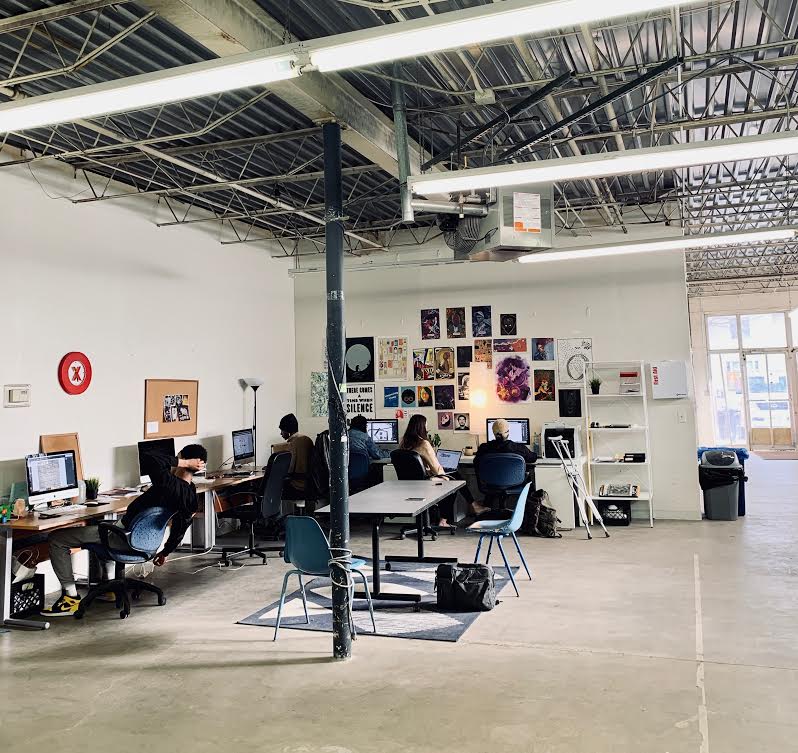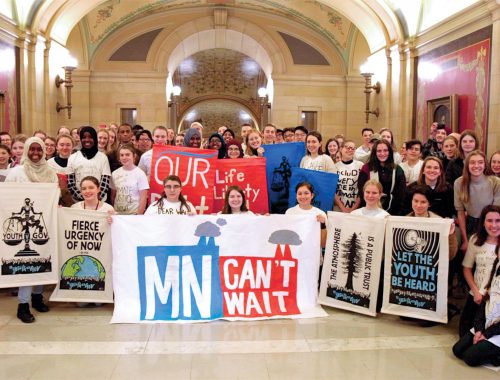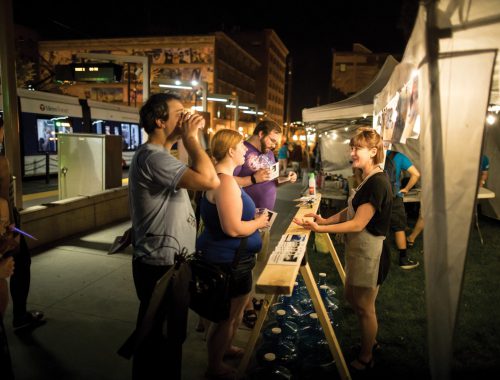
Putting Art In Everyone’s Hands: A Q&A With Juxtaposition Arts

Immediately walking into Juxtaposition Arts, I was welcomed by happy faces from the young people that were working there. The environment was very open and inviting and it was a very collaborative and creative space. There was art covering the walls and the youth were hard at work creating their graphics, as well as working on ideas for future summer community outreach.
Preston Dorsett, an apprentice working in the environmental design lab, brought me over to a group discussion that was taking place where they were testing out new ways to interact with the community. This was in preparation for part of their summer community outreach projects. By working as a team and having an open discussion, they were able to use the materials they were given to think creatively and collaboratively.
Juxtaposition Arts, based in North Minneapolis, is a nonprofit youth education center for the arts. JXTA aims to provide a creative and open environment for all the youth that are involved in the organization, as well as build a strong community through creative thinking, art education and community outreach. In addition to an art and design center, JXTA is also a social enterprise that employs and trains young people in studio based learning and work.
Juxtaposition Arts offers different art programs for youth, as well as beneficial internship and job opportunities that provide young people with real world work experience. Some of the programs offered are the Visual Art Literacy Training (VALT), which is a free college level drawing course offered year round that preps participants for future work opportunities and apprenticeships through the organization. The apprenticeships for teens are split into different labs depending on the specialty they want to work in. The apprenticeships offered at JXTA are in graphic design, textiles and screen printing, public art and murals, environmental design, contemporary art and tactical urbanism. Another program offered is Free Wall: Introduction to Aerosol Painting.

Preston Dorsett, an environmental design apprentice at JXTA, sat down to talk about the organization, its impact on young people in the community and how it has been successful in sustaining art for youth.
Preston has been working at JXTA for half a year as an apprentice in the environmental design lab. He first applied for the VALT (Visual Art Literacy Training) course, which is available for youth ages 12 to 21. After taking the course, he was able to apply for a job at JXTA, present a portfolio of his work from the VALT course and interview for a position. After going through that process he was able to choose the lab he wanted to work in.
What do you do as an environmental design apprentice?
“It varies depending on the job we get and it also depends on the season. So in the summertime, it’s mostly community outreach and we are often on our bikes biking around and doing different workshops with the community. We get commission to do those by other companies that need some sort of community outreach, but then in the winter we do a lot of graphic design and infographics just because that’s what we can do without having an outside space to build stuff, and usually those things are tied to environmental design.”
So you are designing for other companies, correct?
“Yeah, we’re designing for whatever company pays us, like we just finished up on a comic book to go with a toy that this guy developed, and we’ve done different pamphlets to go out to the community to inform them on changes that are happening to their roads or any kind of construction. I think people also really see the value in a community of kids, especially from the north side. They kind of want that culture.”
Do you think this organization is helping sustain the arts for youth?
“Yeah, for sure. So especially from the VALT class, it’s pretty much a drawing class and it’s really comprehensive for kids that think they can’t draw, but this class shows you that drawing is pretty easy if you have the time and proper tools to do it.
It gives kids confidence to be artistic and then gives them a job and pays them to exercise that artistic ability that they have.”
So JXTA has good connections with other companies when it comes to getting additional jobs?
“They can help you get other internships with other companies and we work with other companies, too. We work with some really legit companies actually, like we do projects for the Guthrie and the city. We end up meeting a lot of people.”
Why do you think art is important? Do you think youth need it?
“Yeah, I think it’s super important. Especially I think in this context of it being kind of like opportunity. A lot of times, art can be for financial gain or it’s kind of a “rich person’s” thing, in terms of people that are consuming it. I think this is giving kids that normally wouldn’t have the opportunity not only to experience art, but to be able to express themselves through it, that they wouldn’t normally.
By doing that, and by listening to people that are never listened to, there are some really incredible new ideas that otherwise wouldn’t have been revealed. It’s important for building community, and it’s important for an individuals mind and it can expand your way of viewing things.”
Do you think this organization has opened your eyes to new kinds of art and/or ways of thinking about art?
“I’m lucky and I was always into art, but it has definitely expanded and kind of brought me down to reality in that sometimes you don’t always get what you want. You sometimes have to, to be an successful artist, adapt to whatever you can make money off of, not making money in a predatory way like ‘we need to make this money’, but in a ‘you need to make enough money to sustain yourself and exist’ kind of way. It definitely has sobered me up to realizing the kind of path of an artist that eventually makes money.”
After talking with Preston, I wanted to hear a little bit more about the organization through the eyes of individuals that have worked at JXTA for a long time and have seen the organization grow. I sat down with Kristen Murray – Director of Programs and Tactical Urbanism Lab Lead, as well as Adrienne Doyle – Tactical Lab Lead and Development Associate.
How has this organization helped the youth in the community with their everyday lives?
Adrienne – “I think it helps young people by obviously getting professional experience with clients and creative projects that impact the built environment in North Minneapolis. They see their marketing in the real world and they get practice talking about their work and their process.”
How long have you been open as an organization? Has the organization grown over the years?
Adrienne – “JXTA started in 1995 as an after-school arts workshop. It was created for young people that are smart, but not necessarily successful in traditional education environments, with the intention of changing young people to be able to excel in art making, drawing or aerosol art, and then be able to make money off of that, like selling products or exhibiting artwork in galleries and making revenue for yourself and for your community.
JXTA trains young people and through this, they are also able to connect to opportunities outside the organization where they can make money in the creative economy We have relationships with Target and with Knot Inc, and they can get internships there which often leads to them being asked back for a job.”
Kristen– “It’s grown and evolved but stayed grounded in the core principles that the founders had.”
And you create artwork and graphics for those companies, correct?
Adrienne – “Yeah, Target, Lunds and Byerly’s, 3M, and there are more examples.”
Why do you think it’s really important to have this organization when it comes to sustaining art for youth?
Kristen – “For me, a lot of learning that gets lifted up more often as “real learning” or as “credential learning”, happens in classrooms and institutes for formal education. In reality, there’s a lot of important learning that is done in real world projects and by doing real-world work in inter-generational settings. That needs to get lifted up as valid learning as well.”
Adrienne – “I started at JXTA in 2010 as a youth participant, when they were highlighting the lab internships. I think spaces like JXTA are important because they recognize the inherent value that people have in their community, and they invest in it through training, provided opportunities for training, creative training, internships and attention. They also recognize that young people have an important role in their communities, and art can be used for that.”










